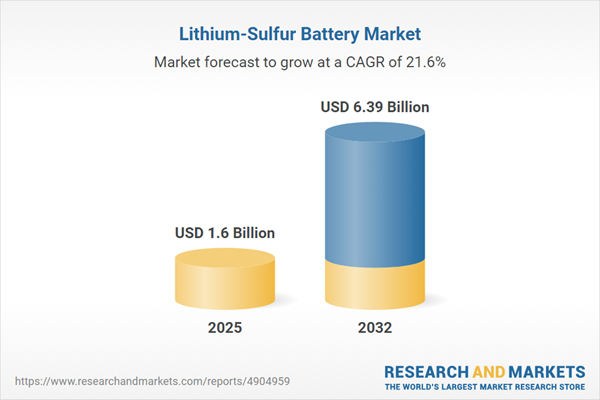Speak directly to the analyst to clarify any post sales queries you may have.
Senior executives in energy storage must navigate evolving technologies and regulatory landscapes. Robust lithium-sulfur battery market intelligence supports confident leadership, helps benchmark strategies, and clarifies new opportunities amid sector transformation.
Lithium-Sulfur Battery Market Snapshot
The lithium-sulfur battery market is positioned for robust growth, underpinned by investor interest and advancements in manufacturing and materials science. As of 2024, the market value stands at USD 1.33 billion, with projections reaching USD 1.60 billion by 2025 and a compound annual growth rate (CAGR) of 21.58%. By 2032, the market could achieve USD 6.39 billion in size. Increased demand for advanced energy storage technologies across aerospace, automotive, and industrial sectors drives this expansion, while ongoing innovation in chemistry and design continues to push performance and regulatory compliance standards worldwide.
Scope & Segmentation of the Lithium-Sulfur Battery Market
This strategic analysis supports senior leaders seeking insights into shifting technologies, supply networks, and regulatory influences. Market segments enable tailored approaches for business, compliance, and growth initiatives across regions and industries:
- Type: High energy density and low energy density batteries align with industry-specific needs, from automotive and grid storage to portable electronics.
- Components: Enhanced anode and cathode materials, in addition to emerging electrolytes like ether-based and ionic liquid systems, drive longer life cycles and improved operational efficiency.
- Capacity: Segments include batteries with less than 500 mAh for portable and mobile uses, and those exceeding 1,000 mAh for industrial and infrastructure-scale storage.
- State: Liquid, semi-solid, and solid-state battery configurations increase applicability, meet diverse safety and environmental regulations, and support integration into various energy systems.
- Application: The sector addresses aerospace, defense, automation, medical technology, consumer electronics, and grid-scale energy storage, with each segment requiring distinct technical and regulatory adaptations.
- Regions: Growth and competition span the Americas, Europe, Middle East & Africa, and Asia-Pacific. Attention centers on the U.S., Germany, China, Japan, India, Brazil, GCC, and Australia, shaping both collaborative and competitive market dynamics.
- Key Companies: BASF SE, Gelion PLC, Giner Inc., GS Yuasa International Ltd., LG Energy Solution Ltd., Sion Power Corporation, Solid Power, Inc., and VTC Power Co. lead research, product development, and market expansion via partnerships and investment strategies.
Lithium-Sulfur Battery Market: Key Takeaways for Senior Leaders
- Advancements in sulfur nanostructuring and development of solid-state systems broaden use cases across mobile and stationary energy storage projects.
- Adoption of roll-to-roll manufacturing techniques enhances production efficiency and supports a more reliable supply chain.
- Collaborative partnerships between manufacturers, suppliers, and research bodies are strengthening innovation pipelines and building sector resilience.
- Increased use of recycled and domestic materials aligns with global sustainability requirements and evolving market benchmarks.
- Flexible operating models empower organizations to adapt quickly to changing regulatory frameworks and sustain competitive positioning.
- Coordinated supplier and management strategies ensure alignment with dynamic sustainability goals and stakeholder expectations.
Tariff Impact and Supply Chain Shifts
Impending U.S. tariffs targeting lithium-sulfur battery components, scheduled for 2025, require organizations to optimize supply chain structures and enhance domestic manufacturing capacity. These developments intensify competitive pressures across regions, reshape procurement agreements, and demand greater agility and regulatory skill to minimize risk and secure emerging sourcing advantages.
Methodology & Data Sources
This market intelligence is grounded in secondary research, informed by in-depth interviews with industry experts, and reviewed by subject matter specialists. Senior stakeholder feedback ensures that results align with current sector realities and address priorities critical to lithium-sulfur battery commercialization and adoption.
Why This Report Matters
- Enables executive teams to anticipate technology cycles and supply chain changes, supporting proactive strategic decision-making within the lithium-sulfur battery market.
- Identifies actionable market entry and expansion pathways, as advances in energy storage and compliance regulations create new opportunities.
- Offers objective, expert-backed insights to reinforce competitive positioning amid industry transformation.
Conclusion
Continuous monitoring of innovation and regulation equips business leaders to adapt and drive success in energy storage. Leadership teams well informed on lithium-sulfur market trends can advance growth and resilience in evolving international markets.
Additional Product Information:
- Purchase of this report includes 1 year online access with quarterly updates.
- This report can be updated on request. Please contact our Customer Experience team using the Ask a Question widget on our website.
Table of Contents
3. Executive Summary
4. Market Overview
7. Cumulative Impact of Artificial Intelligence 2025
Companies Mentioned
The companies profiled in this Lithium-Sulfur Battery market report include:- BASF SE
- Gelion PLC
- Giner Inc.
- GS Yuasa International Ltd.
- Hybrid Kinetic Group
- Ilika PLC
- Iolitec Ionic Liquids Technologies GmbH
- Johnson Matthey PLC
- LG Energy Solution Ltd.
- Li-S Energy Limited
- Lyten, Inc.
- NexTech Batteries Inc.
- PolyPlus Battery Company
- Rechargion Energy Private Limited
- Sion Power Corporation
- Solid Power, Inc.
- VTC Power Co.,Ltd
- WAE Technologies Limited
- Zeta Energy LLC
Table Information
| Report Attribute | Details |
|---|---|
| No. of Pages | 182 |
| Published | November 2025 |
| Forecast Period | 2025 - 2032 |
| Estimated Market Value ( USD | $ 1.6 Billion |
| Forecasted Market Value ( USD | $ 6.39 Billion |
| Compound Annual Growth Rate | 21.5% |
| Regions Covered | Global |
| No. of Companies Mentioned | 20 |









